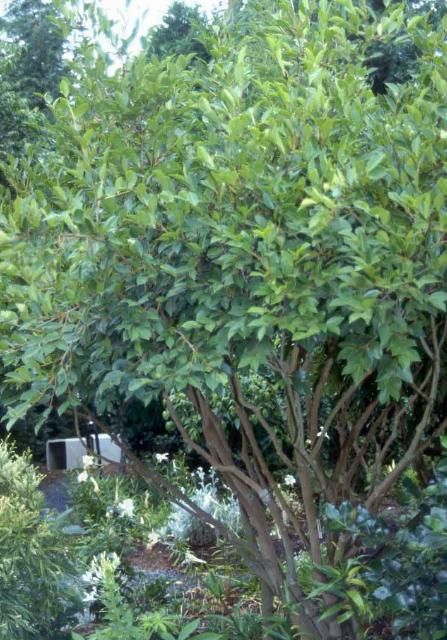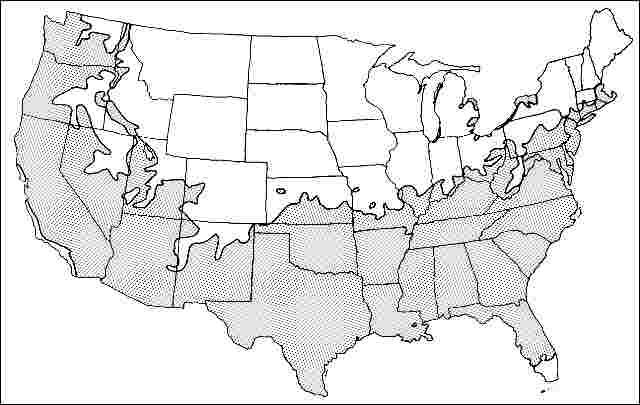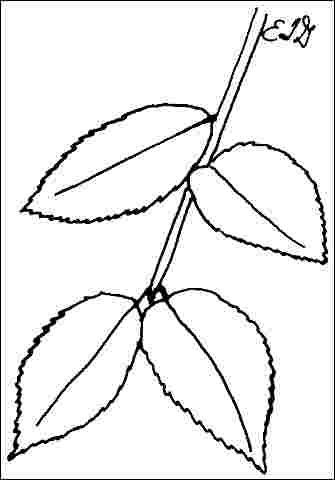Introduction
Tea-oil camellia are so named because they are cultivated in their native homeland of China specifically for the seeds, from which is extracted commercial tea oil. This particular Camellia species looks much like Camellia sasanqua except the dark green, evergreen leaves are a bit larger, three to five inches long and two to three inches wide. Single, white, fragrant flowers are produced in late winter, and this large shrub or small tree will reach a height of 20 feet with thin, upright, multiple trunks and branches. The crown forms a rounded or oval vase with lower branches removed.

Credit: Ed Gilman
General Information
Scientific name: Camellia oleifera
Pronunciation: kuh-MEEL-ee-uh oh-lee-IF-er-uh
Common name(s): Tea-oil camellia
Family: Theaceae
USDA hardiness zones: 6A through 9B (Fig. 2)
Origin: not native to North America
Invasive potential: little invasive potential
Uses: specimen; hedge; screen; street without sidewalk; container or planter; deck or patio; trained as a standard; parking lot island < 100 sq. ft.; parking lot island 100–200 sq. ft.; parking lot island > 200 sq. ft.; sidewalk cutout (tree pit); tree lawn 3–4 feet wide; tree lawn 4–6 feet wide; tree lawn > 6 ft. wide; highway median; Bonsai
Availability: not native to North America

Description
Height: 15 to 20 feet
Spread: 10 to 15 feet
Crown uniformity: symmetrical
Crown shape: vase, round
Crown density: dense
Growth rate: slow
Texture: medium
Foliage
Leaf arrangement: alternate (Fig. 3)
Leaf type: simple
Leaf margin: serrate
Leaf shape: obovate, oblanceolate
Leaf venation: pinnate
Leaf type and persistence: evergreen, broadleaf evergreen
Leaf blade length: less than 2 inches, 2 to 4 inches
Leaf color: green
Fall color: no color change
Fall characteristic: not showy

Flower
Flower color: white/cream/gray
Flower characteristics: showy
Fruit
Fruit shape: round
Fruit length: .5 to 1 inch
Fruit covering: dry or hard
Fruit color: unknown
Fruit characteristics: does not attract wildlife; not showy; fruit/leaves not a litter problem
Trunk and Branches
Trunk/bark/branches: branches droop; not showy; typically multi-trunked; thorns
Pruning requirement: little required
Breakage: resistant
Current year twig color: brown
Current year twig thickness: medium
Wood specific gravity: unknown
Culture
Light requirement: full sun, partial sun or partial shade
Soil tolerances: clay; sand; loam; acidic; slightly alkaline; well-drained
Drought tolerance: moderate
Aerosol salt tolerance: unknown
Other
Roots: not a problem
Winter interest: no
Outstanding tree: yes
Ozone sensitivity: unknown
Verticillium wilt susceptibility: unknown
Pest resistance: resistant to pests/diseases
Use and Management
Plants should require little pruning and their dense, compact, crown makes them ideally suited for informal borders, specimens, accents, and sheared or natural hedges or screens. Large specimens may be trimmed to multi- or single-trunked small trees. This is a great tree for planting along a street beneath power lines since it will not require pruning by the utility company, but unfortunately it is not yet readily available. Nurseries should grow and market this plant in a multi-stemmed and single-trunked form for this purpose.
Tea-oil camellia should be grown in full sun or partial shade on rich, moist, acid soils. It will tolerate drought once established and grows well in clay soil.
Propagation is by seed or cuttings.
Pests
Watch for scale infestation.
Diseases
No diseases are of major concern.